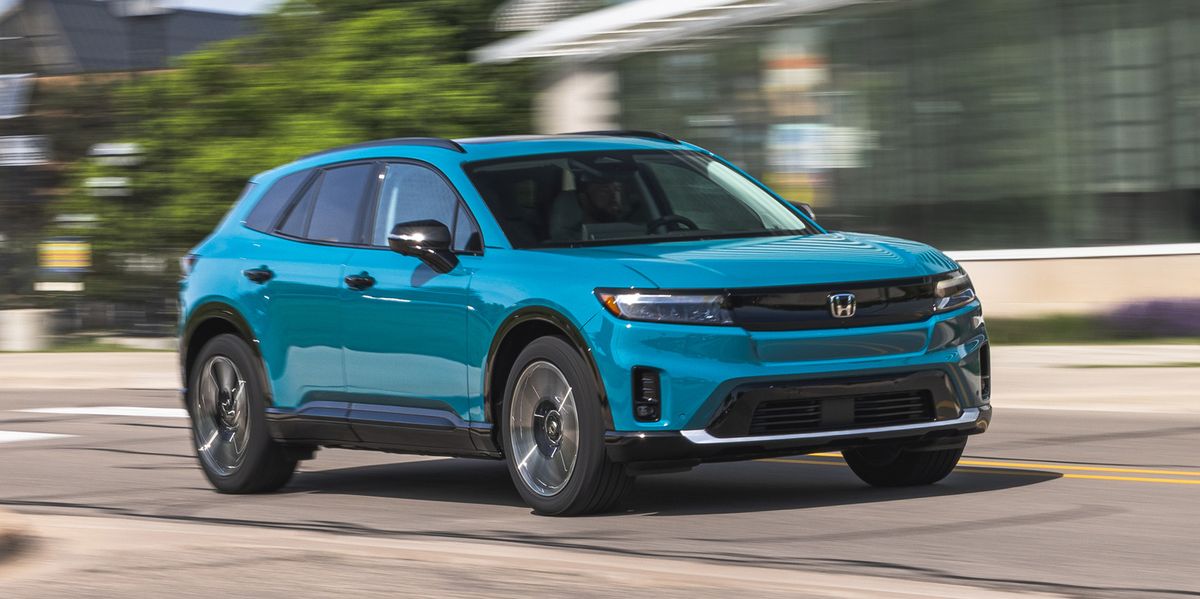
TESTED: 2024 HONDA PROLOGUE IS A BETTER EV THAN IT IS A HONDA
06/19/24 UPDATE: This review has been updated with test data from a Prologue Elite AWD.
Honda has decided that it wants to sell an EV in the U.S., for real this time. While previous models such as the Fit EV and the Clarity Electric were experimental projects sold in small numbers mostly on the West Coast, Honda challenged itself to market a "volume EV," bringing higher expectations for broad appeal and widespread availability. Because Honda's proprietary EV plans won't be ready until 2026, it turned to General Motors to create the 2024 Prologue, which shares its platform, its battery, and other components with Chevy's electric mid-size SUV, the Blazer EV. The next challenge was to make the Prologue look and feel like a Honda.
On the styling front, the Prologue succeeds. Its smooth, simplistic front end has a bland, friendly-looking face incorporating a blocked-off grille and unassuming headlights. The slab-sided profile and clean-looking rear end with a new "Honda" script provide visual distinction between this and the Blazer, and the Prologue will look at home in a Honda showroom next to the two-row Passport and the three-row Pilot. In terms of size, it also fits neatly between those two, although its roof is significantly lower.
Step inside the Prologue, and the Honda vibes are less apparent. Honda says it adjusted some of the dashboard's hard points to provide a lower cowl and better sightlines than the Blazer has, a welcome change. But GM switchgear still abounds. This isn't inherently a problem, and the materials look and feel appropriate for this price. But we do think that a buyer who has owned three CR-Vs and is finally looking to go electric will balk at the unfamiliar layout of frequently used controls. The windshield wipers, for instance, are operated by the stalk to the left of the steering wheel, rather than the right stalk typical of Hondas, and the headlights are controlled from a menu within the touchscreen. The 11.3-inch central screen also has a somewhat convoluted arrangement of apps that will take some getting used to. That's not very Honda-like. At least the Prologue has Android Auto and Apple CarPlay functions, unlike the Blazer EV.
How It Drives
Engineers say they also had a heavy hand in the suspension tuning, with the goal of making the Prologue drive like a Honda. We can report that the Prologue is quiet, planted, and comfortable on the road—positive traits for sure, but hardly Honda specific. A 5268-pound electric crossover will never provide the tactility of a Civic Si, anyway, nor would its buyers want it to, but we wished for more engagement and feedback from the numb steering. Still, when driven back to back, we preferred driving the Prologue to its Blazer sibling, as the Honda's slightly softer tuning felt more coherent than the Chevy and its sharper responses.
We tested the 288-hp dual-motor Elite model, which offers all-wheel drive and smooth power delivery but not enough grunt to shove you back in your seat. The acceleration doesn't come close to that of the dual-motor Hyundai Ioniq 5 and Kia EV6, which both sprint to 60 mph in 4.5 seconds and produce plenty of grins along the way. The Prologue is more responsive than a V-6-powered Passport or Pilot, but not by much—at the track, it got to 60 mph in 5.9 seconds, tying the last Passport we tested. We imagine the front-wheel-drive single-motor Prologue, with just 212 ponies, will feel sluggish. You can select from multiple levels of regenerative-braking capability, including a one-pedal driving mode, and GM's handy steering-wheel-mounted regen paddle is onboard, offering an easy way to get maximum regen on demand.
Charging and Range
An 85.0-kWh battery, one of GM's Ultium units, sits underneath the floor. It provides competitive EPA range figures of 273 to 296 miles, depending on the configuration and trim level. In our testing, the Elite, which gets a 273-mile rating, achieved a 240-mile highway-range result, competitive but not outstanding. Its maximum DC fast-charging capability of 150 kilowatts is also competitive, and we saw a 158-kW max during our 10–90 percent charge test, where the Prologue averaged 97 kilowatts and added 100 miles of real-world highway range in 17 minutes. For reference, an Ioniq 5 we tested peaked at 235 kilowatts and averaged 152 kilowatts, adding 100 miles in 13 minutes.
Honda also throws in a nice charging package that allows customers to choose between various bundles of credits that can be applied at EVgo and Electrify America stations and to home charging installations. That's the kind of stuff that makes the transition to an EV easier for first-timers, and the Prologue is eligible for the $7500 federal tax credit. That could make its price range of $48,795 to nearly $60,000 a bit easier to stomach—if you qualify for the credit, of course. The dual-motor Touring version, theoretically just under $50,000 with the tax credit applied, seems like the best value of the lineup.
The Prologue does a lot of things right for a mainstream EV, especially if you're a brand-agnostic shopper. Its range and charging capabilities are competitive, and it provides a refined driving experience with EV-specific bonuses such as one-pedal driving and a quiet cabin. We question whether it will please the Honda faithful, though; while it looks like a typical Honda SUV on the outside, its convoluted interior controls and lack of driving verve are disappointing, given the badge it wears. For those who value Honda's expertise in these areas, it may be best to wait a few years for the next generation of true Honda-built Honda EVs to arrive.